Overview of Taken Initiatives and Adaptation Measures in Polish Mining Companies during a Pandemic
Abstract
:1. Introduction
- Economic (including the withholding of many investments, a decline in demand for the raw material produced, loss of strategic customers, loss of liquidity, a reduction in employee wages, a decline in the company’s stock market value and the need to find additional capital to purchase protective measures for employees);
- Organisational (e.g., limiting contact between employees to the minimum necessary, organising underground transport in accordance with the guidelines for the number of people, reorganising working hours, introducing remote working for some positions, supplying mines with an adequate amount of protective and disinfecting agents, organising teams to supervise the disinfection process of premises and workplaces, the need to temporarily ban external stakeholders from entering the mine site);
- Health-related (e.g., problems with access to protective equipment, insufficient quantity in the initial phase, workers’ fear of illness, organisation of medical points or preparation of workplace accident management).
2. Literature Review
3. Materials and Methods
- Analyse the guidelines for the operation of mining plants during the SARS-CoV-2 epidemic;
- Analyse miners’ behaviour in relation to the introduced restrictions;
- Identification of sites in mining plants particularly exposed to virus infection;
- Review of actions taken and initiatives by the selected coal company;
- Indications and analyses of the effects of a pandemic from the social and economic perspective.
- Analyse publicly available materials, reports and publications on the pandemic in the mining industry,
- Analyse orders and procedures in force in coal companies during the pandemic,
- IDI—In-depth interviews with representatives of mines, mining companies and industry experts, in which we supplemented the previously obtained information,
- Analyse materials and data provided by the mining company,
- Analyse industry and sector data regarding mining and the analysed company contained in the EMIS database.
4. Results and Discussion
4.1. Guidelines for the Operation of Mining Plants during a SARS-CoV-2 Outbreak
- providing workers with the means to protect their mouths and noses and covering them compulsorily were indicated by law; this obligation applies to all suppliers and visitors moving on the premises;
- use of distance barriers (e.g., glass, plexiglass to protect the worker from the possibility of infection from sick persons;
- maintaining a safe distance between workstations (1.5 m) as far as possible;
- reducing the number of working shifts and reducing working hours to six hours, use of distance barriers (e.g., glass, plexiglass to protect the employee against the possibility of infection from sick people;
- reducing contact between employees (changing the work system and identifying where employees congregate, introducing remote working where possible, halving the number of people entering the shaft hoist cage and being transported by transport equipment, and increasing the number of descents in shafts);
- restricting the use of communal spaces (different break times, closing canteens or limiting the number of people who can be there, the possibility of a breakfast break at the workstation, limiting the number of people using the baths);
- use of routine personal protective equipment by underground workers;
- updating cleaning and preventive decontamination procedures for rooms and areas (e.g., circulation paths, offices, cloakrooms, sanitary rooms, lamp rooms, refreshment points, stairwells);
- displaying instructions in the sanitary and hygiene rooms on hand washing, donning and doffing masks and gloves;
- suspension of periodic in-house training and introduction of online training;
- limitation of external cooperation;
- staff briefings should take place in an open space and meetings and deliberations, if necessary, with windows open;
- designating crisis management centres that make decisions depending on the situation.
- if there are symptoms of infection, workers should not come to work,
- an employee who has developed symptoms of infection should report to the nearest sanitary-epidemiological station,
- introduction of non-contact temperature measurement before entering the establishment; if a temperature above 37 degrees Celsius or if a person is observed to have a persistent cough, malaise or difficulty breathing, such a worker should not be allowed to enter the establishment,
- preparing the room to isolate the worker who develops symptoms of infection,
- prominently displayed numbers for medical services and sanitary and epidemiological stations.
4.2. Need to Identify Plants Particularly Vulnerable to Coronavirus Infection
- employee transport;
- entrance/exit gates;
- main traffic routes;
- guildhalls—Places where work is shared;
- sanitary and hygienic facilities;
- lamp room;
- above the shaft and below the shaft—Places where the crew goes down and up;
- underground transport by passenger trains and overhead rail;
- beverage dispensing points.
4.3. Adaptation Initiatives and Activities Undertaken at a Selected Mining Company
4.4. Behavioural Response of the Mining Community to the Tightening Measures Introduced
4.5. Economic and Social Impact of the COVID-19 Pandemic on Mining Facilities and Miners
- Remuneration;
- Employee benefits;
- Materials;
- Depreciation;
- Outsourced services;
- Other costs by type.
5. Conclusions
Author Contributions
Funding
Institutional Review Board Statement
Informed Consent Statement
Data Availability Statement
Acknowledgments
Conflicts of Interest
References
- Kowal, B.; Wiśniowski, R.; Ogrodnik, R.; Młynarczykowska, A. Selected Elements of a Safe Work Environment in Hard Coal Mines in the Polish Mining Sector. J. Pol. Miner. Eng. Soc. 2019, 2, 215–223. [Google Scholar] [CrossRef]
- Kustra, A.; Ranosz, R.; Kowal, B. Model of the process of preparing annual technical and economic plans in the public sector. J. Pol. Miner. Eng. Soc. 2020, 21, 211–215. [Google Scholar] [CrossRef]
- Ranosz, R.; Bluszcz, A.; Kowal, D. Conditions for the innovation activities of energy sector enterprises shown on the example of mining companies. J. Pol. Miner. Eng. Soc. 2020, 21, 249–256. [Google Scholar] [CrossRef]
- Lubosik, Z.; Jaroszewicz, J. Zagrożenie Wirusem SARS-CoV-2 w Kopalniach Podziemnych—Wybrane Zagadnienia; Główny Instytut Górnictwa: Katowice, Poland, 2020. (In Polish) [Google Scholar]
- Folwarczny, M. Crisis Management in Mining Companies in the Event of an Epidemic Threat. J. Pol. Miner. Eng. Soc. 2020, 2, 33–40. [Google Scholar] [CrossRef]
- Sennewald, C.A.; Baillie, C. Crisis management. In Effective Security Management, 7th ed.; Butterworth-Heinemann: Oxford, UK, 2020; pp. 199–205. [Google Scholar] [CrossRef]
- Jowitt, S. COVID-19 and the Global Minig Industry. SEG Dicovery 2020, 122, 33–41. [Google Scholar] [CrossRef]
- Sukiennik, M.; Kowal, B. Analysis and Verification of Space for New Businesses in Raw Material Market—A Case Study of Poland. Energies 2022, 15, 3042. [Google Scholar] [CrossRef]
- Bluszcz, A. European Economies in terms of energy dependence. Qual. Quant. 2017, 51, 1531–1548. [Google Scholar] [CrossRef]
- Kijewska, A.; Bluszcz, A. Research of varying levels of greenhouse gas emissions in European countries using the k-means method. Atmos. Pollut. Res. 2016, 7, 935–944. [Google Scholar] [CrossRef]
- Kowal, B.; Domaracká, L.; Tobór-Osadnik, K. Innovative activity of companies in the raw material industry on the example of Poland and Slovakia—Selected aspects. J. Pol. Miner. Eng. Soc. 2020, 2, 71–77. [Google Scholar] [CrossRef]
- Tobór-Osadnik, K.; Wyganowska, M.; Brejdak, A.; Kowal, B. Pro-social Activities within the CSR by the Jastrzębska Spółka Węglowa SA—A Case Study. J. Pol. Miner. Eng. Soc. 2020, 2, 47–52. [Google Scholar] [CrossRef]
- Bluszcz, A.; Manowska, A. Differentiation of the Level of Sustainable Development of Energy Markets in the European Union Countries. Energies 2020, 13, 4882. [Google Scholar] [CrossRef]
- Culková, K.; Pavolová, H.; Khouri, S.; Шутькo, Л. Development of the economy of the mineral sector: An example of the countries of the eastern european quarter. Econ. Innov. Manag. 2020, 3, 77–87. [Google Scholar] [CrossRef]
- European Commission. Available online: https://ec.europa.eu/clima/policies/strategies/2050_en (accessed on 5 May 2022).
- European Commission. Available online: https://ec.europa.eu/info/strategy/priorities-2019-2024/europeangreen-deal_en (accessed on 5 May 2022).
- Manowska, A.; Nowrot, A. The importance of heat emission caused by global energy production in terms of climate impact. Energies 2019, 12, 3069. [Google Scholar] [CrossRef]
- JD. Closure of Mines. Support Will Be Required Up to 36 Thousand Miners. Available online: https://www.wnp.pl/gornictwo/likwidacja-kopaln-wsparcia-wymagac-bedzie-nawet-36-tys-gornikow,445844.html (accessed on 10 May 2022).
- PWC. Energy Industry and COVID-19 (Coronavirus): Strategising for the ‘New Normal’. Available online: https://www.pwc.com/gx/en/issues/crisis-solutions/covid-19/energy-utilities-resources-coronavirus.html (accessed on 15 May 2022).
- De Blasis, R.; Petroni, F. Price Leadership and Volatility Linkages between Oil and Renewable Energy Firms during the COVID-19 Pandemic. Energies 2021, 14, 2608. [Google Scholar] [CrossRef]
- Bąk, P. Good Practices to Counteract Epidemic Emergency in Mining Companies in Poland. Energies 2022, 15, 5500. [Google Scholar] [CrossRef]
- Gałas, A.; Kot-Niewiadomska, A.; Czerw, H.; Simic, V.; Tost, M.; Wårell, L.; Gałas, S. Impact of COVID-19 on the Mining Sector and Raw Materials Security in Selected European Countries. Resources 2021, 10, 39. [Google Scholar] [CrossRef]
- Zhong, H.; Tan, Z.; He, Y.; Xie, L.; Kang, C. Implications of COVID-19 for the electricity industry: A comprehensive review. CSEE J. Power Energy Syst. 2020, 6, 489–495. [Google Scholar]
- Siksnelyte-Butkiene, I. Impact of the COVID-19 Pandemic to the Sustainability of the Energy Sector. Sustainability 2021, 13, 12973. [Google Scholar] [CrossRef]
- Gersdorf, T.; Hensley, R.; Hertzke, P.; Schaufuss, P. Electric Mobility after the Crisis: Why an Auto Slowdown Won’t Hurt EU Demand. 16 September 2020. Available online: https://www.mckinsey.com/industries/automotive-and-assembly/our-insights/electric-mobility-after-the-crisis-why-an-auto-slowdown-wont-hurt-ev-demand (accessed on 12 June 2022).
- Kumar, A.; Singh, P.; Raizada, P.; Hussain, C.M. Impact of COVID-19 on greenhouse gases emissions: A critical review. Sci. Total Environ. 2022, 806, 150349. [Google Scholar] [CrossRef]
- Deb, P.; Furceri, D.; Ostry, J.D.; Tawk, N. The economic effects of COVID-19 containment measures. In Covid Economics Vetted and Real-Time Papers; International Monetary Fund: Washington, DC, USA, 2020; Volume 24, pp. 32–35. [Google Scholar]
- Zheng, B.; Geng, G.; Ciais, P.; Davis, S.J.; Martin, R.V.; Meng, J.; Wu, N.; Chevallier, F.; Broquet, G.; Boersma, F.; et al. Satellite-based estimates of decline and rebound in China’s CO2 emissions during COVID-19 pandemic. Sci. Adv. 2020, 6, eabd4998. [Google Scholar] [CrossRef]
- Lu, H.F.; Ma, X.; Ma, M.D. Impacts of the COVID-19 pandemic on the energy sector. J. Zhejiang Univ. Sci. A 2021, 22, 941–956. [Google Scholar] [CrossRef]
- Chen, S.T.; Kuo, H.I.; Chen, C.C. The relationship between GDP and electricity consumption in 10 Asian countries. Energy Policy 2007, 35, 2611–2621. [Google Scholar] [CrossRef]
- Chen, S.; Igan, D.; Pierri, N.; Presbitero, A. Tracking the Economic Impact of COVID-19 and Mitigation Policies in Europe and the United States; IMF Working Paper; International Monetary Fund: Washington, DC, USA, 2020; Available online: https://www.elibrary.imf.org/view/journals/001/2020/125/001.2020.issue-125-en.xml (accessed on 7 July 2022).
- Fezzi, C.; Fanghella, V. Real-Time Estimation of the Short-Run Impact of COVID-19 on Economic Activity Using Electricity Market Data. Environ. Resour. Econ. 2020, 76, 885–900. [Google Scholar] [CrossRef] [PubMed]
- Memmott, T.; Carley, S.; Graff, M.; Konisky, D.M. Sociodemographic disparities in energy insecurity among low-income households before and during the COVID-19 pandemic. Nat. Energy 2021, 6, 186–193. [Google Scholar] [CrossRef]
- Nagaj, R.; Korpysa, J. Impact of COVID-19 on the Level of Energy Poverty in Poland. Energies 2020, 13, 4977. [Google Scholar] [CrossRef]
- Biernat-Jarka, A.; Trębska, P.; Jarka, S. The Role of Renewable Energy Sources in Alleviating Energy Poverty in Households in Poland. Energies 2021, 14, 2957. [Google Scholar] [CrossRef]
- Siksnelyte-Butkiene, I. Combating Energy Poverty in the Face of the COVID-19 Pandemic and the Global Economic Uncertainty. Energies 2022, 15, 3649. [Google Scholar] [CrossRef]
- Clark, I.K.H.; Chun, S.; O’Sullivan, K.C.; Pierse, N. Energy Poverty among Tertiary Students in Aotearoa New Zealand. Energies 2022, 15, 76. [Google Scholar] [CrossRef]
- Mamica, L.; Glowacki, J.; Makiela, K. Determinants of the Energy Poverty of Polish Students during the COVID-19 Pandemic. Energies 2021, 14, 3233. [Google Scholar] [CrossRef]
- Strojny, J.A.; Chwastek, M.S.; Badach, E.; Lisek, S.J.; Kacorzyk, P. Impacts of COVID-19 on Energy Expenditures of Local Self-Government Units in Poland. Energies 2022, 15, 1583. [Google Scholar] [CrossRef]
- Pilipczuk, O. Determinants of Managerial Competences Transformation in the Polish Energy Industry. Energies 2021, 14, 6788. [Google Scholar] [CrossRef]
- Report. Assessment of Work Safety, Assessment of Occupational Safety, Mine Rescue and General Safety in Connection with Mining and Geological Activities in 2021; Wyższy Urząd Górniczy: Katowice, Poland, 2022. (In Polish) [Google Scholar]
- Raport. Assessment of Work Safety, Mine Rescue and General Safety in Connection with Mining and Geological Activities in 2020; Wyższy Urząd Górniczy: Katowice, Poland, 2021. (In Polish) [Google Scholar]
- Kowal, B.; Świniarska, O. Overview of Safety Initiatives Taken by Mining Companies during the Pandemic by ESG Pillars; Wydawnictwo Politechniki Śląskiej w Gliwicach: Gliwice, Poland, chapter in the monograph; unpublished. (In Polish)
- Sasin, J. Guidelines of the Minister of State Assets and the Chief Sanitary Inspector for the Functioning of the Mine during the SARS-CoV-2 Epidemy; Minister Aktywów Państwowych: Warszawa, Poland, 2020. (In Polish)
- Bąk, P.; Kapusta, M.; Sukiennik, M. Mining company management in case of the epidemic emergency. J. Pol. Miner. Eng. Soc. 2020, 2, 231–235. [Google Scholar] [CrossRef]
- Regulation of the Council of Ministers of 6 May 2021 on Establishing Certain Restrictions, Orders and Bans in Connection with an Epidemic, Warszawa 2021. Available online: https://dziennikustaw.gov.pl/D2021000086101.pdf (accessed on 26 April 2022). (In Polish)
- Kasiarz, M. Sustainable Development as a New Requirement of Corporate Strategies. Available online: https://www.ey.com/pl_pl/biuletyn-ryzyka/zrownowazony-rozwoj-jako-nowy-wymog-strategii-przedsiebiorstw (accessed on 28 April 2022). (In Polish).
- Fidos, A. What Has the Last 12 Months Brought to the CSR Area? Available online: https://www.proto.pl/aktualnosci/csr-ewoluuje-w-esg-co-zmienilo-sie-w-2021-roku-w-obszarze-spolecznej-odpowiedzialnosci (accessed on 2 May 2022). (In Polish).
- Lubosz, A. The Impact of COVID-19 on the Behavior of Miners in a Selected Coal Mine Support Systems in Production Engineering, Energy and Mining—Prospects for Sustainable Development. Sci. J. Syst. Wspomagania 2020, 10. Available online: http://www.stegroup.pl/attachments/category/71/10.pdf (accessed on 2 June 2022). (In Polish).
- Kamińska-Berezowska, S.; Suchacka, M. Safety and Work Organization Management in the Early Days of the COVID-19 Pandemic in the Lignite Mining and Energy Sector in Poland. Energies 2022, 15, 4239. [Google Scholar] [CrossRef]
- Długosz, P. Social Effects of the COVID-19 Pandemic among Poles. Available online: https://ifis.up.krakow.pl/wp-content/uploads/sites/9/2020/10/Spo%C5%82eczne-skutki-pandemii-w%C5%9Br%C3%B3d-Polak%C3%B3w_raport1.pdf (accessed on 24 May 2022). (In Polish).
- Available online: https://www.jsw.pl/biuro-pra-sowe/aktualnosci/archiwum/artykul-archiwalny/informacja-jsw (accessed on 28 July 2022). (In Polish).
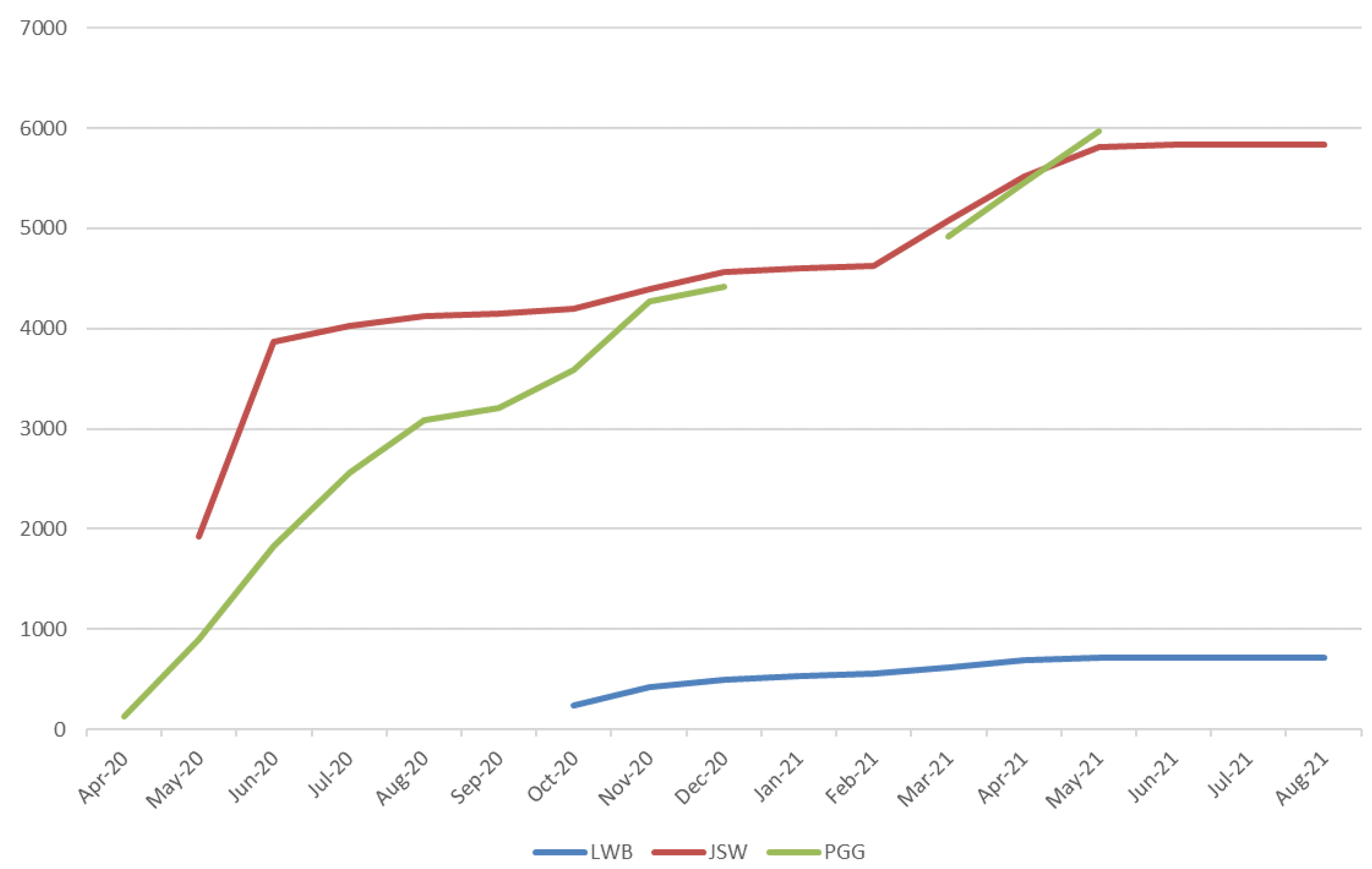
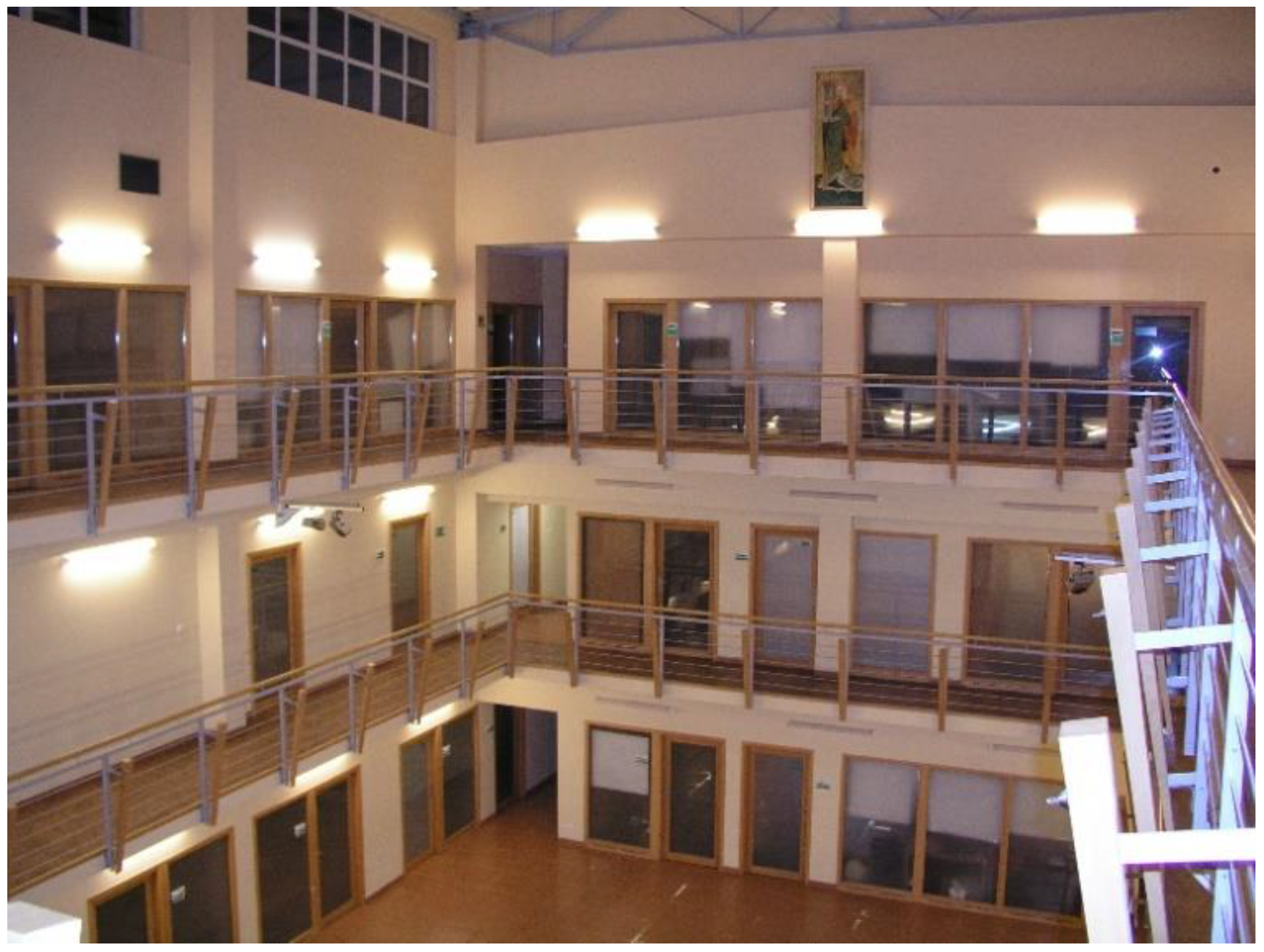
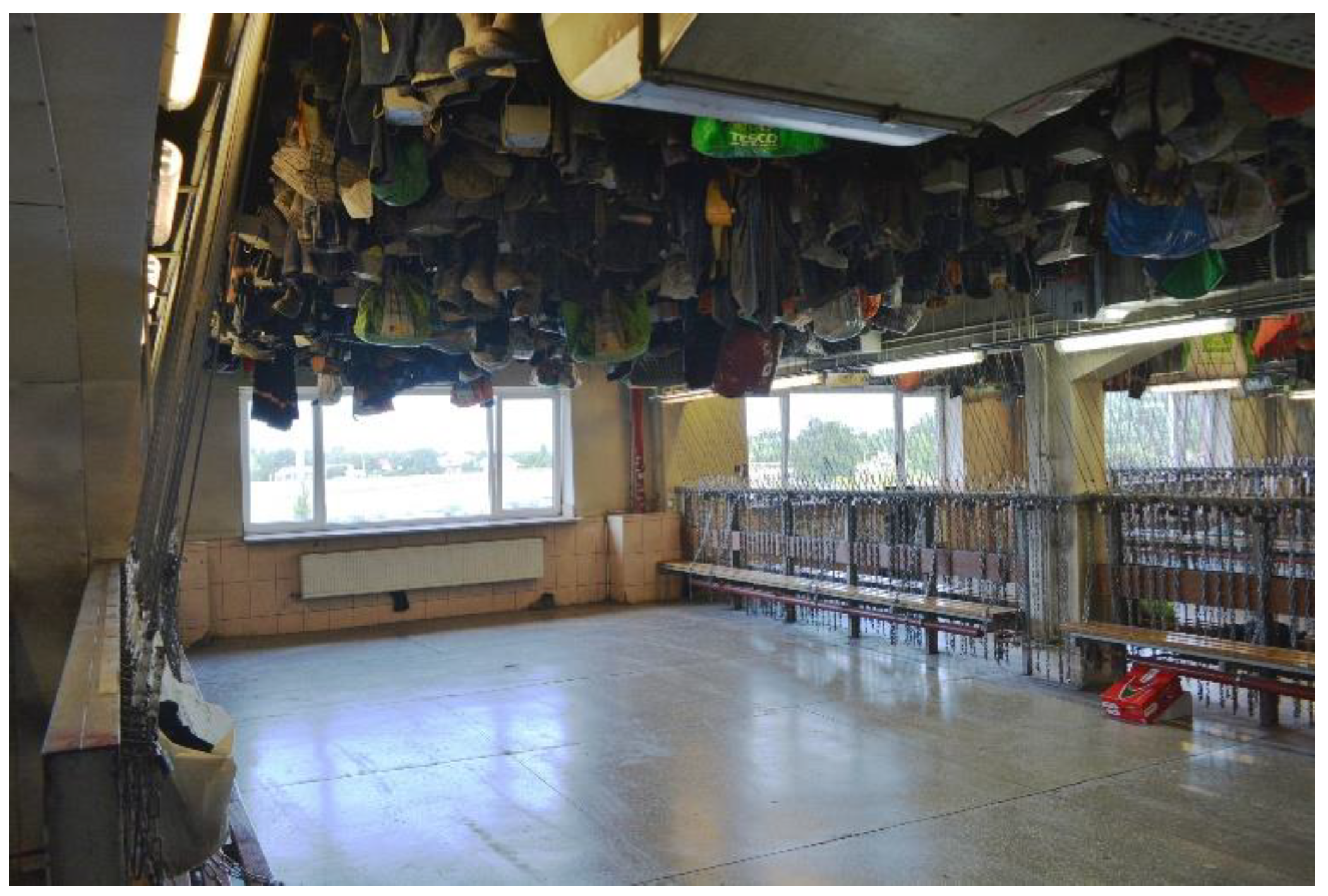

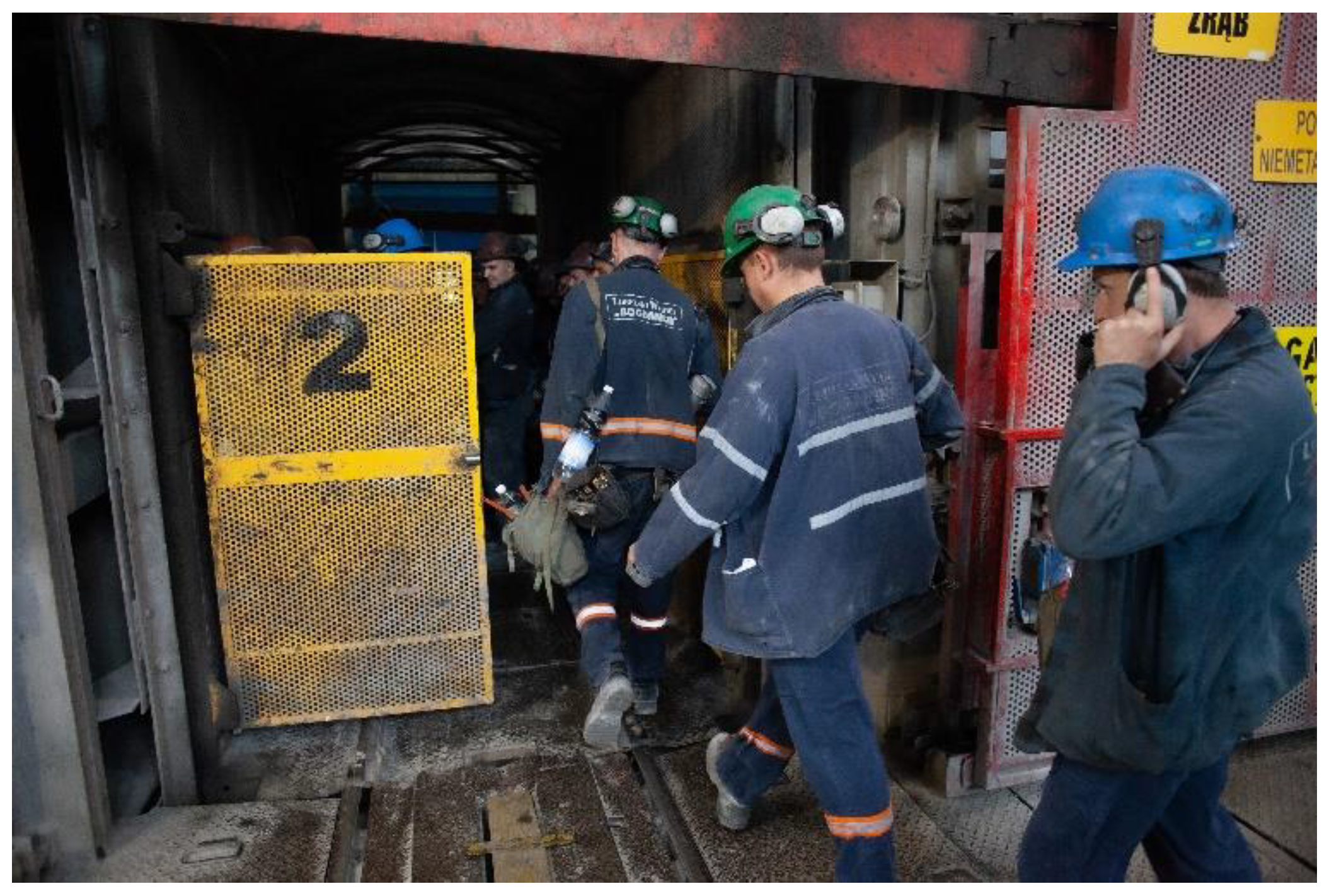

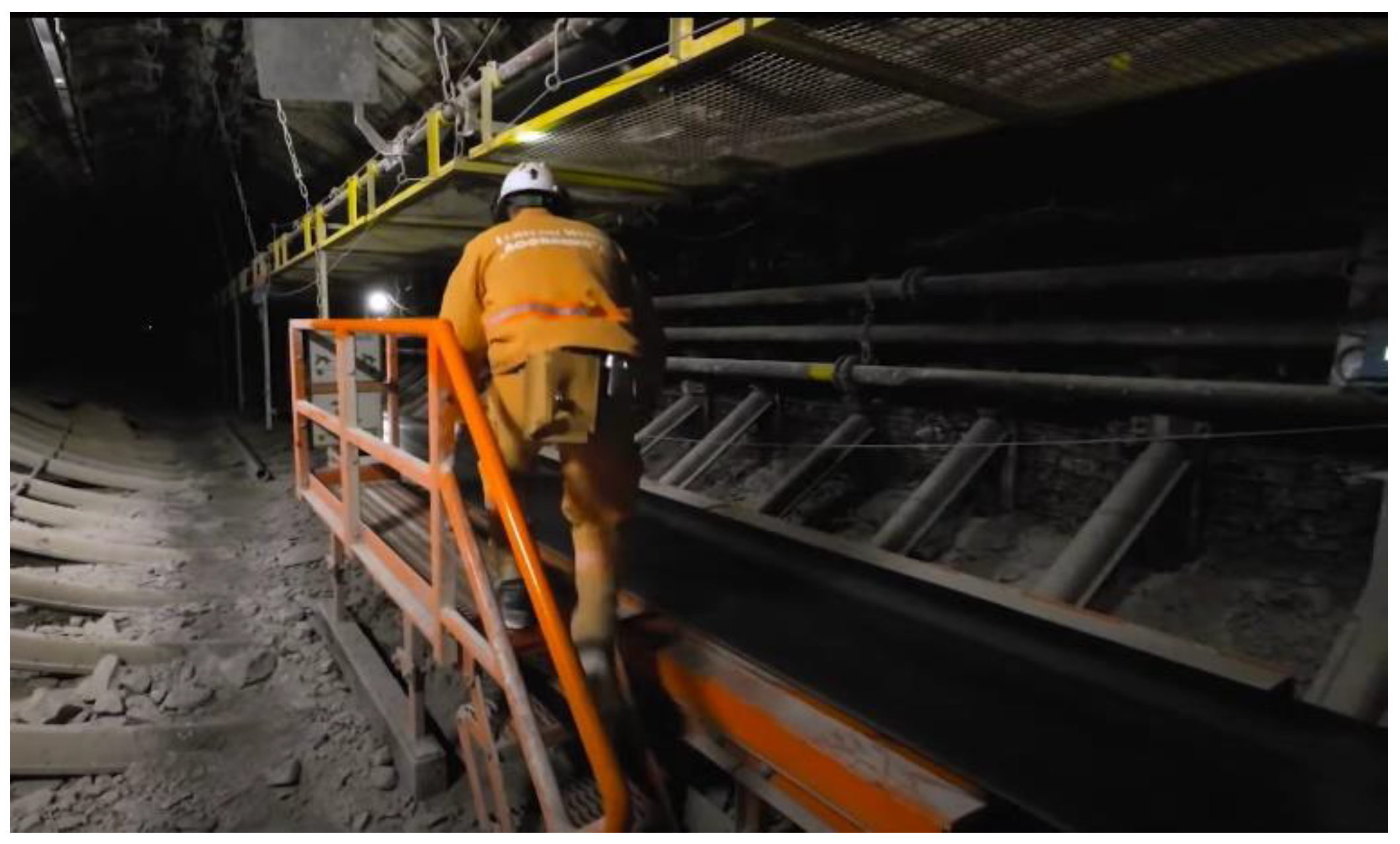
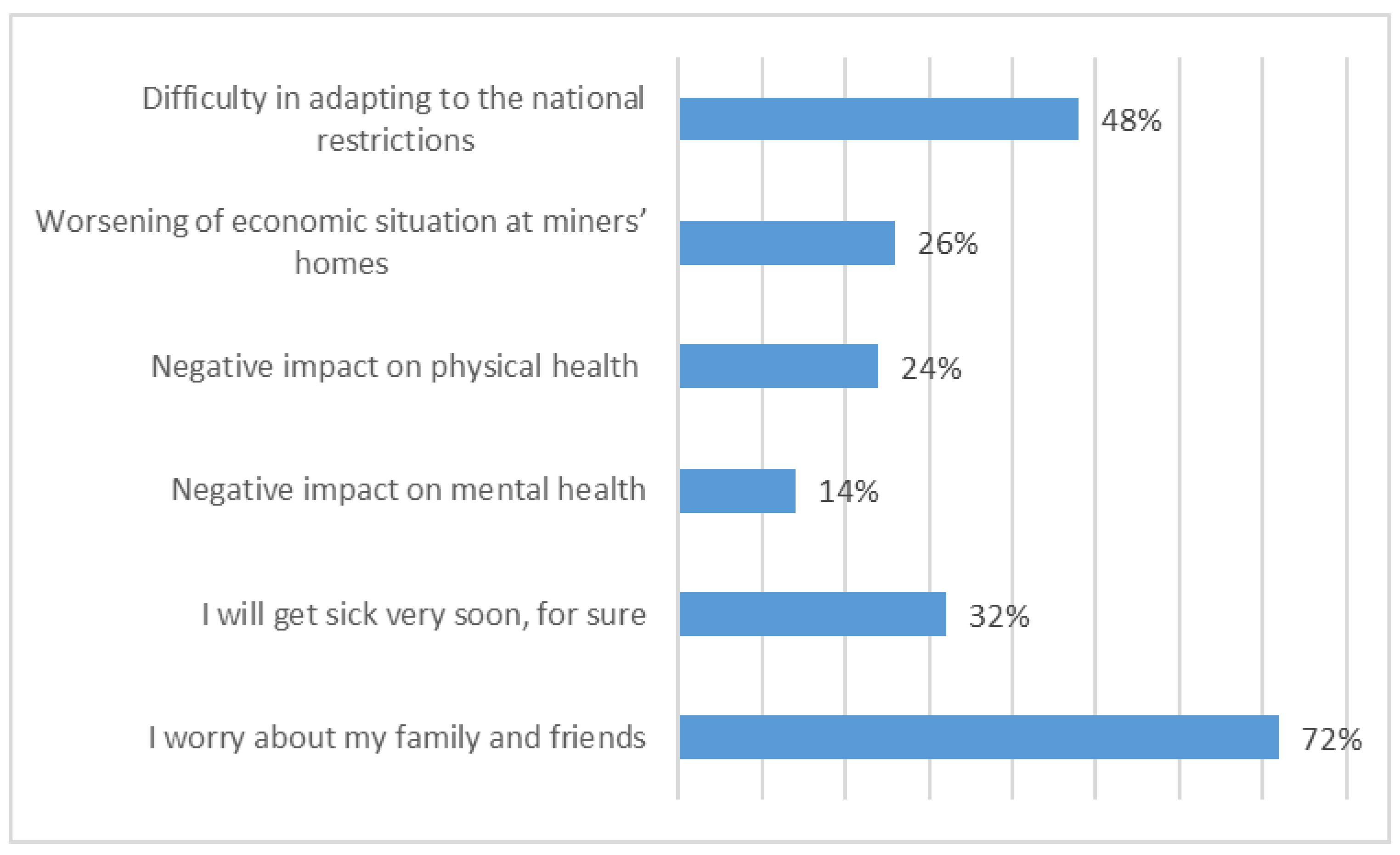

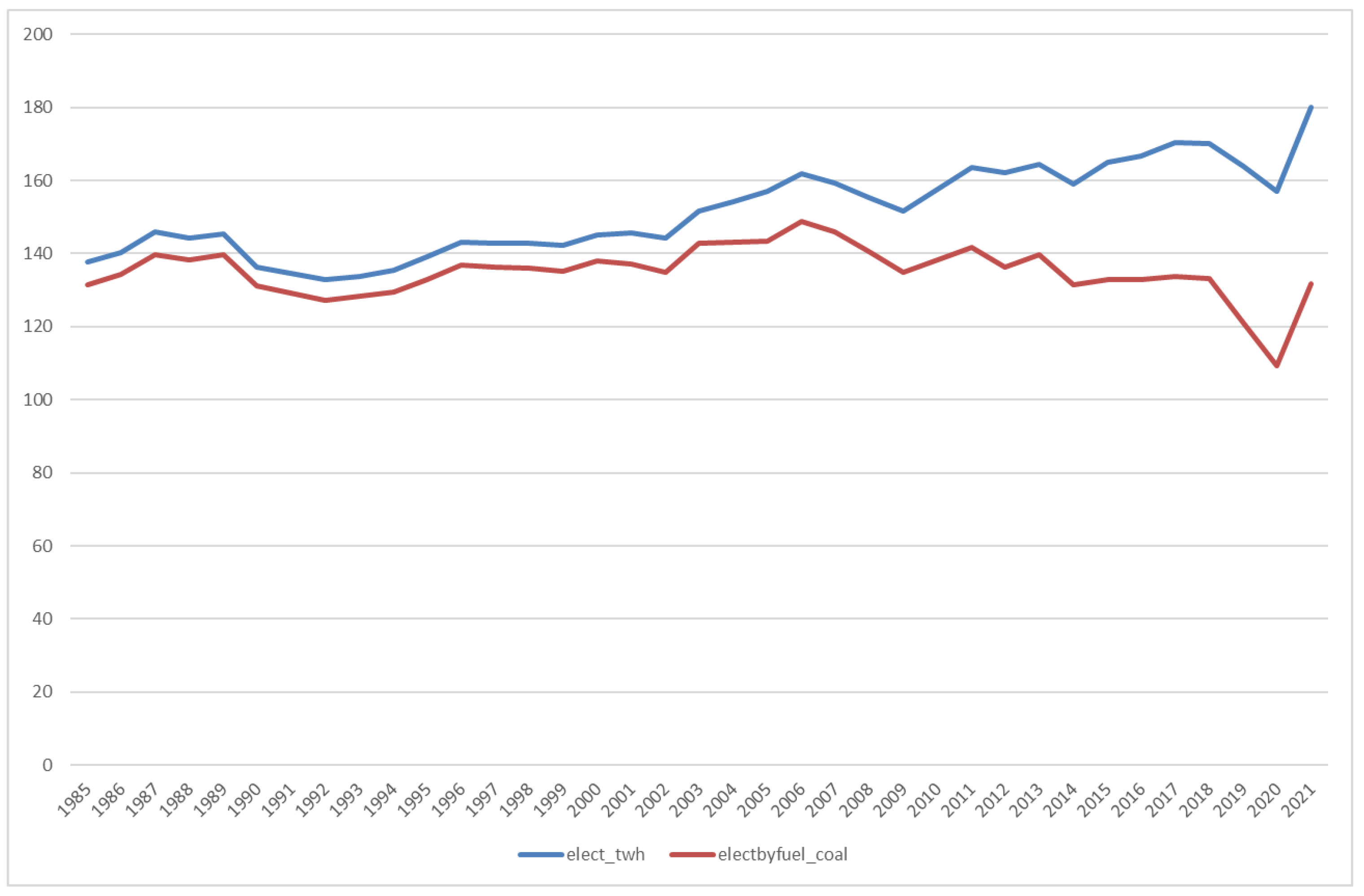
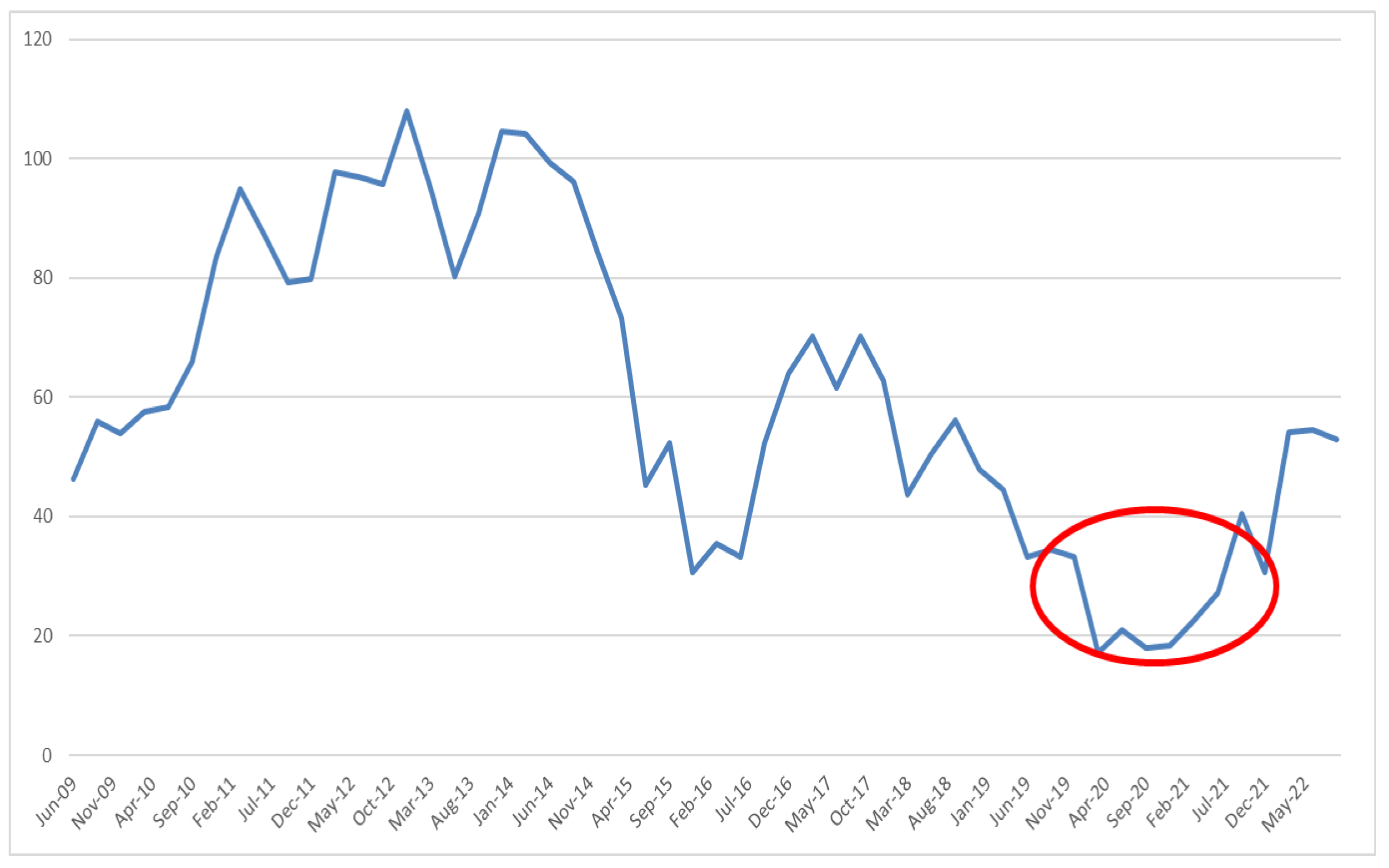
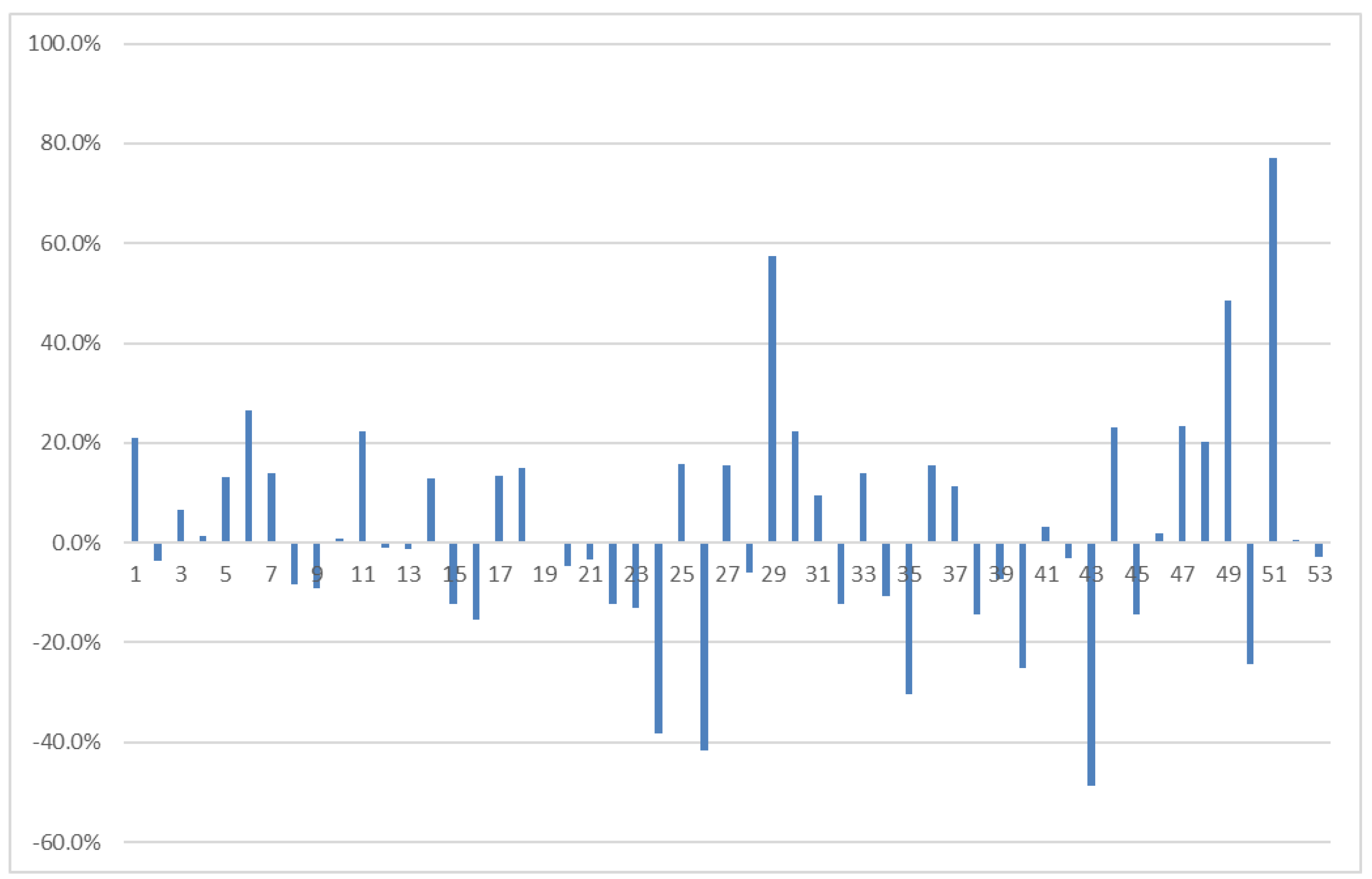
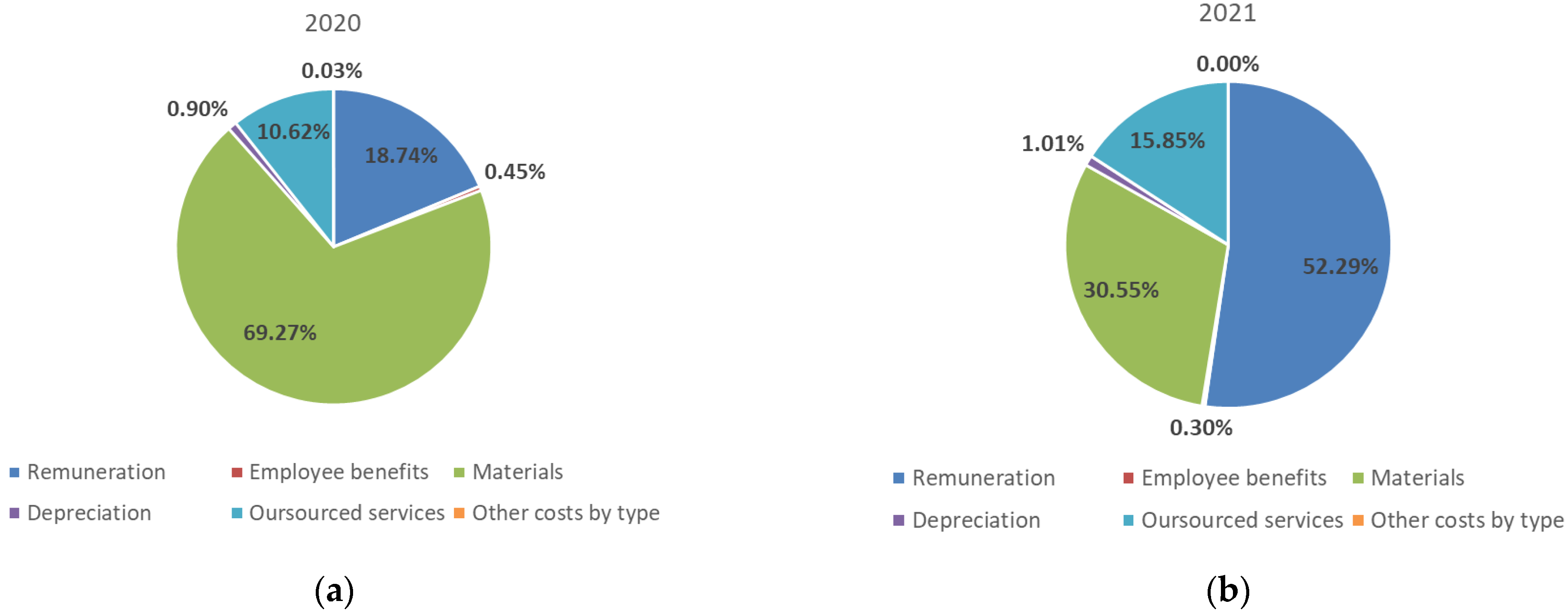
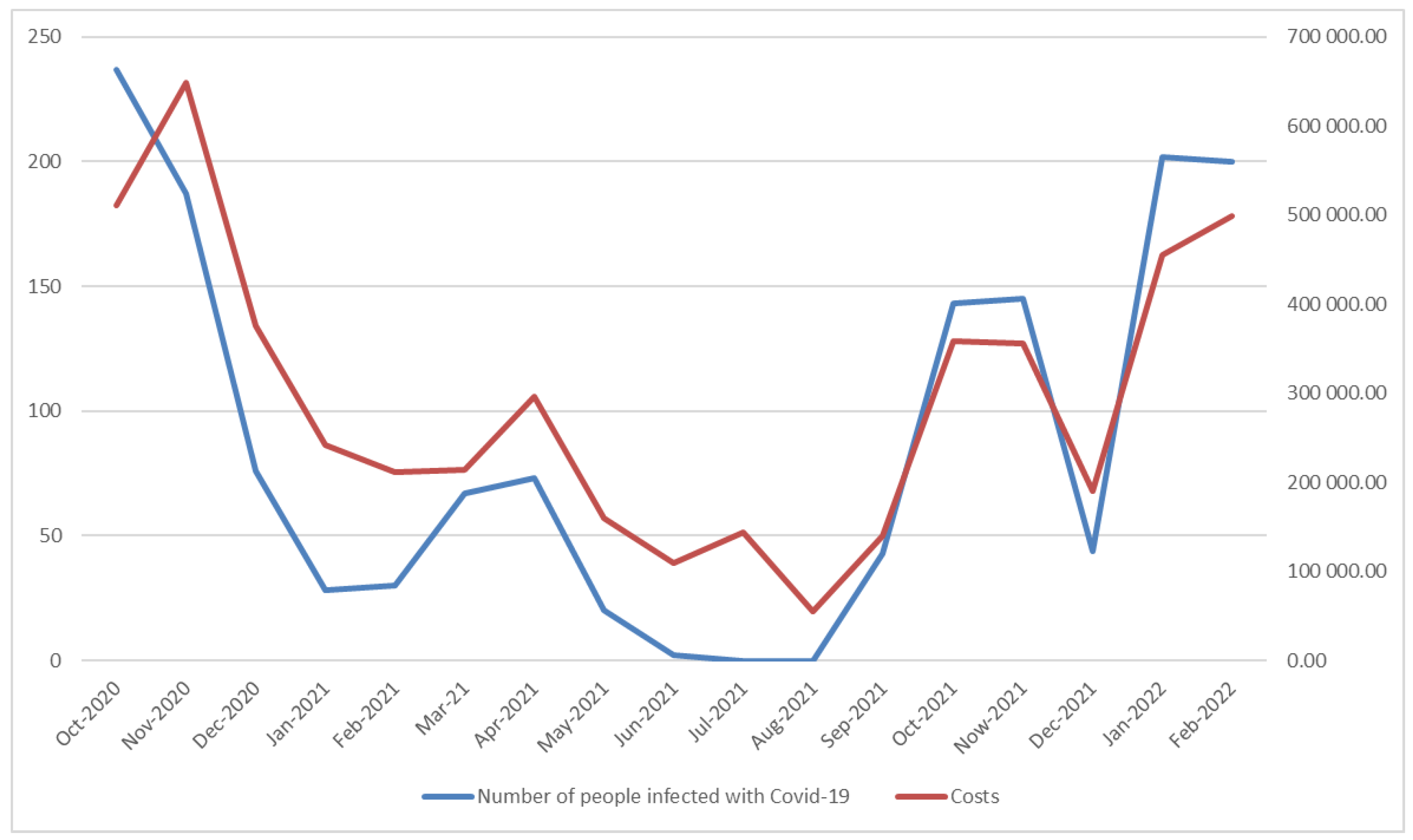
| ESG Pillar | Action, Initiative |
|---|---|
| Governance | establishment of the Crisis Staff monitoring the situation and reporting to the Management Board development of ongoing recommendations implementation of preventive measures development of a plan for maintaining the continuity of the mine’s operations analysis of the financial situation establishment of accounting accounts to monitor costs associated with the prevention and control of coronavirus developing procedures for dealing with symptoms of coronavirus detected in an employee isolation of persons likely to come into contact with the virus definition of new rules for cooperation with external companies |
| Social | obligation to use personal protective equipment against infection temperature measurement obligation information campaigns disinfection of equipment, appliances and workstations distribution of disinfectants throughout the plant division of crews into smaller groups telephone contact indicated, online contact suspension of business trips the introduction of remote working for jobs that do not require on-site presence |
Publisher’s Note: MDPI stays neutral with regard to jurisdictional claims in published maps and institutional affiliations. |
© 2022 by the authors. Licensee MDPI, Basel, Switzerland. This article is an open access article distributed under the terms and conditions of the Creative Commons Attribution (CC BY) license (https://creativecommons.org/licenses/by/4.0/).
Share and Cite
Kowal, B.; Ranosz, R.; Herezy, Ł.; Cichy, W.; Świniarska, O.; Domaracka, L. Overview of Taken Initiatives and Adaptation Measures in Polish Mining Companies during a Pandemic. Energies 2022, 15, 6403. https://doi.org/10.3390/en15176403
Kowal B, Ranosz R, Herezy Ł, Cichy W, Świniarska O, Domaracka L. Overview of Taken Initiatives and Adaptation Measures in Polish Mining Companies during a Pandemic. Energies. 2022; 15(17):6403. https://doi.org/10.3390/en15176403
Chicago/Turabian StyleKowal, Barbara, Robert Ranosz, Łukasz Herezy, Wojciech Cichy, Olga Świniarska, and Lucia Domaracka. 2022. "Overview of Taken Initiatives and Adaptation Measures in Polish Mining Companies during a Pandemic" Energies 15, no. 17: 6403. https://doi.org/10.3390/en15176403
APA StyleKowal, B., Ranosz, R., Herezy, Ł., Cichy, W., Świniarska, O., & Domaracka, L. (2022). Overview of Taken Initiatives and Adaptation Measures in Polish Mining Companies during a Pandemic. Energies, 15(17), 6403. https://doi.org/10.3390/en15176403






